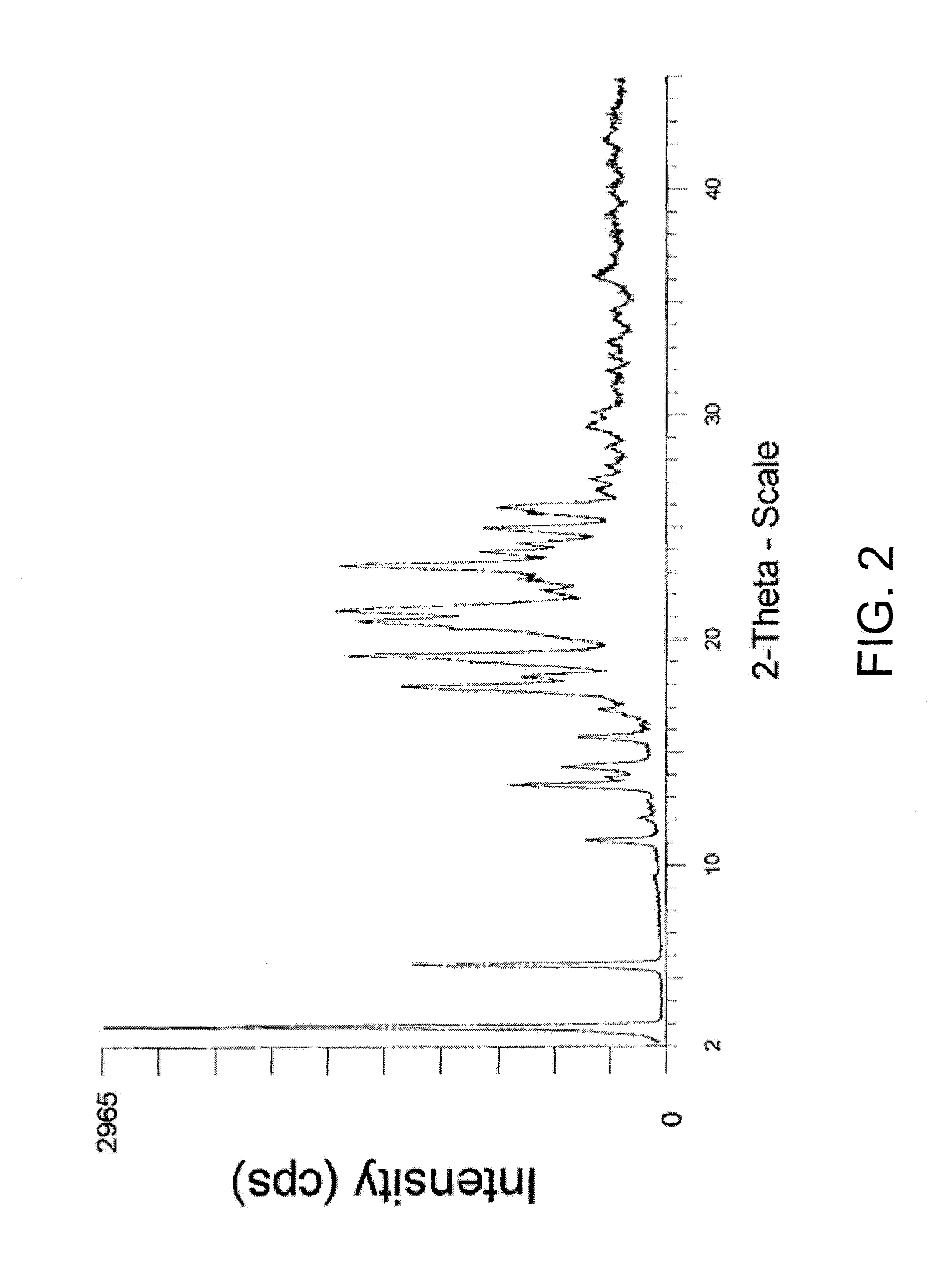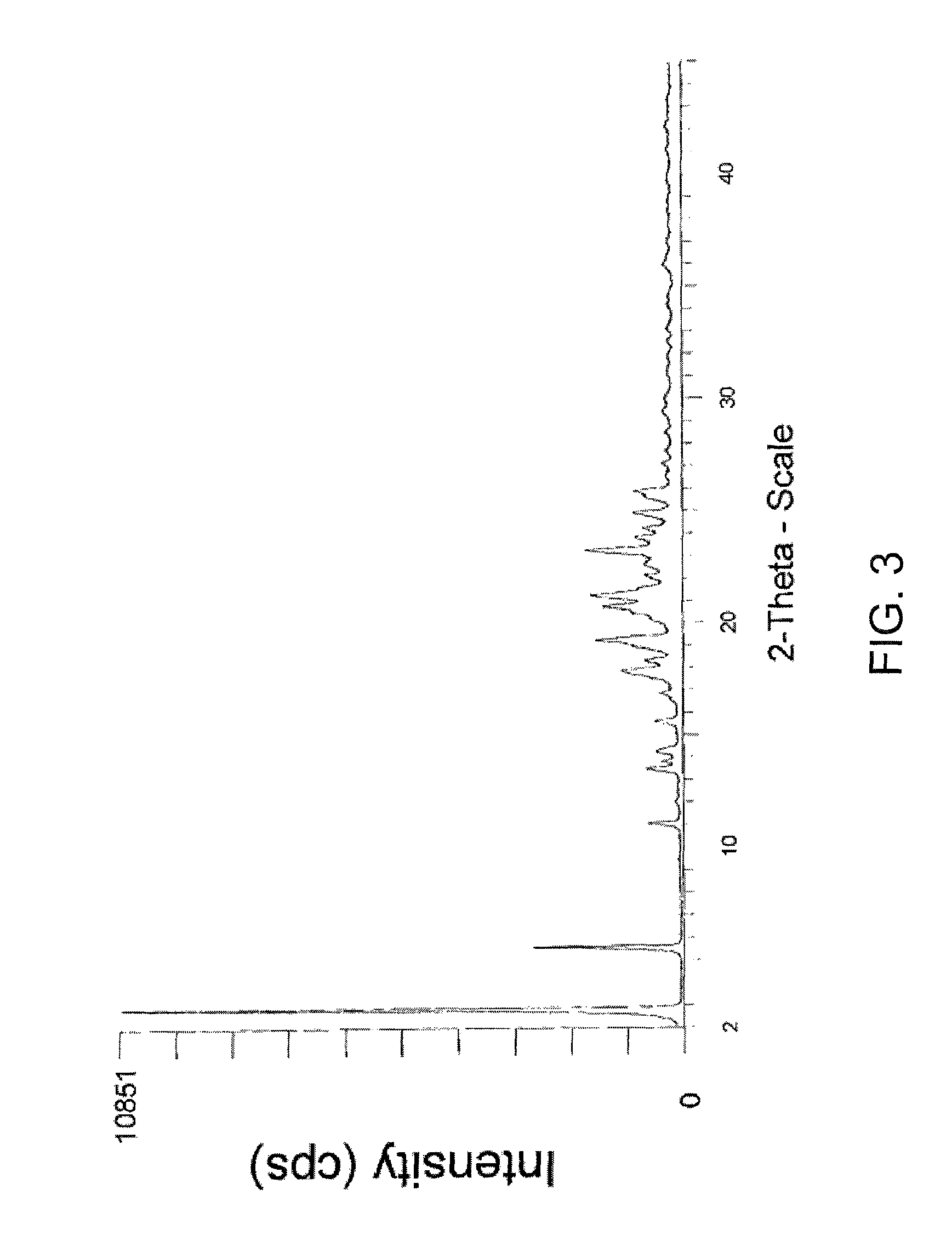Phosphonate ester derivatives and methods of synthesis thereof
a technology of phosphonate ester and derivatives, applied in the field of synthesizing organic chemistry and pharmaceutical science, can solve the problems of limited oral bioavailability and poor membrane permeability, and achieve the effect of high yield
- Summary
- Abstract
- Description
- Claims
- Application Information
AI Technical Summary
Benefits of technology
Problems solved by technology
Method used
Image
Examples
example 1
Preparation of (S)-N1-[(2-hydroxy-3-triphenylmethoxy)propyl]cytosine (CMX212)
[0269]Under an inert atmosphere, e.g., nitrogen, at ambient temperature a reactor was charged with (S)-trityl glycidyl ether (40.0 kg, 126.4 mol), cytosine (12.8 kg, 115.2 mol), potassium carbonate (1.7 kg, 12.3 mol), and anhydrous N,N-dimethylformamide (51.2 kg) and were heated at 85-95° C. for 9 hours. The reaction mixture was cooled to 60-70° C. and quenched with toluene (150.4 kg). The resulting slurry was cooled to −5 to 0° C., filtered, washed with toluene (25.6 kg), and then washed with acetone (3×25.7 kg). The filter cake was suspended in acetone (128.0 kg) and heated at approximately 56° C. for 30 minutes then cooled to below 0° C. and filtered. The cake was washed with acetone (25.6 kg) and dried in vacuo at 45° C. to constant weight yielding 32.4 kg (65.8%) of CMX212 as a white to off white solid. Typical HPLC (AUC) purity was >99% at the wavelength of 274 nm and was >98% at the wavelength of 225...
example 2
Preparation of phosphonic acid, [[(S)-2-(4-amino-2-oxo-1(2H)-pyrimidinyl)-1-(hydroxymethyl)ethoxy]methyl]mono[3-(hexadecyloxy)propyl]ester (CMX001)
[0271]Under an inert atmosphere, e.g., nitrogen, at ambient temperature a reactor was charged with CMX212 (14.5 kg, 33.9 mol), CMX203 (21.2 kg, 37.2 mol), magnesium di-tert-butoxide (6.1 kg, 35.7 mol), and N,N-dimethylformamide (44.9 kg). The reaction mixture was heated at 77 to 83° C. for three to four hours. The reaction mixture was concentrated via distillation until approximately one-half of the N,N-dimethylformamide was removed. The concentrate was diluted with isopropyl acetate (120.1 kg) and the combined organics are washed sequentially with 0.5M HCl (approximately 40 gal.) and brine (40 gal.). The organic phase was distilled to remove the isopropyl acetate. The concentrate was diluted with methanol (87.0 kg) and re-concentrated to remove residual isopropyl acetate. Typical HPLC (AUC) purity of the crude CMX225 was >92% at the wave...
example 3
Preparation of hexadecyl methanesulfonate (4)
[0280]Under an inert atmosphere, e.g., nitrogen, a reactor was charged with 1-hexadecanol 3 (3.78 kg), anhydrous dichloromethane (40 L) and diisopropylethylamine (2.21 kg). The reaction mixture was cooled to −5 to 5° C. and methanesulfonyl chloride (1.87 kg) was added at a controlled rate over 2 hours to ensure that the reaction temperature was kept below 5° C. After the addition was complete, the mixture was warmed to 20 to 30° C. and stirred for one to two hours. The reaction was monitored by GC-MS and was deemed complete when the conversion rate was ≧95%. The reaction was maintained at 20 to 30° C. while being diluted with water (15 L). The organic layer was separated, washed with water (0.50 kg), and concentrated to dryness to yield 4 as a light yellow solid (4.87 kg, 96%). Typical HPLC (AUC) purity was >95%. 1H-NMR was consistent with structure.
[0281]
TABLE 4Summary of Reaction Parameters for 4ReagentRangeOptimal1-hexadecanol1.0 Mol e...
PUM
| Property | Measurement | Unit |
|---|---|---|
| 2θ | aaaaa | aaaaa |
| 2θ | aaaaa | aaaaa |
| 2θ | aaaaa | aaaaa |
Abstract
Description
Claims
Application Information
 Login to View More
Login to View More - R&D
- Intellectual Property
- Life Sciences
- Materials
- Tech Scout
- Unparalleled Data Quality
- Higher Quality Content
- 60% Fewer Hallucinations
Browse by: Latest US Patents, China's latest patents, Technical Efficacy Thesaurus, Application Domain, Technology Topic, Popular Technical Reports.
© 2025 PatSnap. All rights reserved.Legal|Privacy policy|Modern Slavery Act Transparency Statement|Sitemap|About US| Contact US: help@patsnap.com



